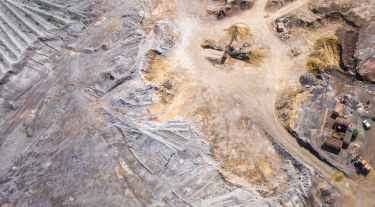Client

Expertise
Decarbonisation strategy
Impact
Igniting action for the Net Zero mines of the future.

Challenge
How can the mining industry balance growing demand for green tech minerals with the need to cut emissions?
Solar panels, wind turbines, electric vehicles, and batteries, all these innovations – and with it, the extraction of minerals and metals – will need to scale if we want to meet the climate goals of the Paris Agreement and reach Net Zero.
Copper and nickel are critical inputs for green technologies. To support the energy transition, their production will need to grow by 200-300% by mid-century. However, significant greenhouse gas (GHG) emissions are associated with their extraction and processing: copper releases 4 tonnes of CO2 per tonne of copper, while nickel production releases 12-78 tonnes of CO2 per tonne.
The mining industry must cut emissions by 90% by 2050, while increasing production to meet demand. This balancing act is no easy undertaking; it requires collaboration, coordination and swift action across the whole value chain.
As a development finance institution, IFC1 is committed to climate action and the sustainable development of critical minerals. As pressure mounts on the mining industry, IFC, the private sector lead of the World Bank Group’s Climate-Smart Mining Initiative, sought to develop a Net Zero roadmap for copper and nickel mining value chains. Together with the Carbon Trust and partners, it wanted to provide guidance on how the Net Zero mine of the future is possible today.
Solution
Constructing a solutions guide for Net Zero mining
IFC, in collaboration with the Carbon Trust, RMI, the Colorado School of Mines, and the Columbia Centre on Sustainable Investment, set out to create a clear vision of how the industry can achieve Net Zero and develop an action-focused decarbonisation plan for copper and nickel mining. For this, it was essential to look at low carbon technology solutions and beyond.
We explored financial support mechanisms, innovation policy support, opportunities for a just transition and other ESG considerations.
The roadmap was developed through a series of in-depth consultations that IFC and partners conducted with over 80 experts from mining (e.g., Anglo American, Rio Tinto, BHP, Vale), energy (e.g. Engie), transport (e.g., Tesla), OEMs (e.g., Komatsu), downstream customers, industry associations (e.g., ICMM, International Copper Association, Nickel Institute), commercial banks, NGOs, and academia. Through close collaboration, the consortium:
While a significant portion of the technology required to achieve Net Zero mining is already accessible and scalable today, research and development investments into technologies like green hydrogen for high heat applications and in transport are still needed. In 2023, IFC launched the Net Zero Roadmap to 2050 for copper and nickel mining value chains.
Impact
Inspiring action towards the mines of the future
The roadmap tackles the crucial issue of greenhouse gas emissions from extraction and processing operations head-on.
Its implementation will provide the foundations for a just energy transition, particularly in the Global South, and propel the mining industry towards a sustainable, Net Zero value chain. Through this work, the World Bank Group’s Climate Smart Mining initiative and IFC were able to provide miners with a toolkit to adopt responsible mining practices and:
1 As a development finance institution focused on the private sector in emerging markets, IFC is committed to climate action and the sustainable development of critical minerals. IFC supports mining companies in building their decarbonisation action plans to ensure the metals and minerals for green technologies are supplied in a resilient, equitable, and sustainable manner.











